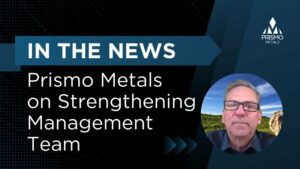9:05 am by Deborah Bacal
 With an operating life of 10 years estimated from the tailings, the companys plan is to generate revenue to explore and develop the large disseminated gold and silver zone associated with the El Tigre vein system.
With an operating life of 10 years estimated from the tailings, the companys plan is to generate revenue to explore and develop the large disseminated gold and silver zone associated with the El Tigre vein system. El Tigre Silver Corp (CVE:ELS) has a two-pronged strategy that sets it apart from other junior explorers in that it has a plan to quickly generate cash flow from the tailings pile of an old mine in Mexico, which will fund the further exploration and development of its flagship resource.
The company owns nine mining concessions, eight of which are spread across 215 square kilometres in the Sierra El Tigre, known as the El Tigre property in Sonora, Mexico. Its first order of business is to build a processing facility to recover silver and gold from a large tailings pile that contains almost 1.4 million tonnes of material a result of 35 years of prior production at the historical El Tigre mine, which stopped operations in 1938.
A prefeasibility study, based on a 400-ton per day mill, estimated a net present value of about $10.9 million on the tailings operation using a discount rate of 8 per cent, as well as a gold price of US$1,289 per ounce and a silver price of US$25 per ounce. The after-tax rate of return was pegged at 53 per cent, with overall initial and sustaining capex estimated at just $6.2 million.
With an operating life of 10 years estimated from the tailings, the companys plan is to generate revenue to explore and develop the large disseminated gold and silver zone associated with the El Tigre vein system. A recently announced NI 43-101 compliant resource report estimated in-situ resources of 24.7 million indicated silver equivalent ounces and over 16 million inferred ounces.
There doesnt seem to be any realistic value given to our stock right now, as the NPV of the tailings is $2 million higher than our market cap, with no value at all given to the main project itself the in-situ resource on the property, says president and CEO Stuart Ross in an interview with Proactive Investors.
The company says it needs $4.5 million to get a shovel in the ground to start construction of its tailings processing facility. The company has expectations that it will close a debt financing shortly as it is currently reviewing offers from potential debt funders.
The projected economics we filed in our 43-101 in July were for a proven mineral reserve. We have now received the environmental permit. There is nothing more that we have to do other than put the money in the bank and start breaking ground, says Ross.
The tailings operation has already been classed as a mining company by Mexican tax authorities, he adds, estimating that the company will need about 12 months from the time it starts constructing to fully commence operations.
As outlined in the companys 43-101, cash operating costs for the tailings operations were estimated at $11.30 per ounce, while total production costs were modeled at $14.44 an ounce. Were going to have a very healthy economic process, asserts the chief executive.
The tailings is just a means to an end, he adds, as we will generate cash to continue to explore and increase the indicated and inferred in-situ resource, which amounts to approximately 41 million silver equivalent ounces in total. Ross figures that at 400 tonnes per day, the company could have a mine approaching 300,000 ounces a year. Indeed, the El Tigre vein system in Sonora State, Mexico lies in the prolific Sierra Madre gold-silver belt, which hosts several precious metals producers, including Pan American Silver Corps 27,700-hectare Dolores Mine that hosts some 87.8 million tonnes of proven and probable reserves.
The sooner we get to [the in-situ resource], the better, says Ross, who explains that the NI 43-101 resource report only covers 1.2 kilometres of a 5.3km vein system. As we move north on that, we believe the resource will increase as the geology is very similar.
The exploration effort is supported by prior work from Anaconda Mining, a company that completed a full district exploration program in the early 1980s. We have their records, drill locations and have digitized their historical database. Its now simply a matter of drilling the rest of it out.
There is even potential to enhance the economics of the tailings operation itself, with material available that can increase head grades, according to the CEO. With the original mine, all the material that came out was hand selected some very high grade. The bulk of material went to the mill, but everything else was discarded. The cut off then was 15 ounces per ton.
Ross says that if the company takes that dump material, which totals about 40,000 to 50,000 tonnes, and mixes it 50/50 with the tailings in processing, it could double the head grade at the tailings production facility. The economics will pretty much double because costs dont increase much. We have to add a crusher and thats it, he affirms, noting that the 43-101 prefeasibility study was based on the processing of the tailings exclusively.
And thats not all. Further upside exists for the operation, as the CEO says there is still some vein material remaining from the original mine near the south of the property, with three adits already there. We wouldnt have to go 400 metres to get it, and that would also increase the head grade of the production facility, driving a higher bottom line.
El Tigre, with a cash position of roughly $0.5 million and a $1.5 million financing in the midst of completion, is getting bullish views from analysts. After the prefeasibility study, Fundamental Research analyst Rajeev Siddharth upped his fair value rating on the company to 44 Canadian cents a share, well above the 13.5 cents it is trading at currently.
And importantly, with precious metals prices so volatile amid an uncertain U.S. economy, Ross says he is confident that El Tigre is at the right end of the scale in terms of costs. Over the long term, Im bullish on silver and gold over a 10-year period. We have all-in costs of $14 an ounce. I dont think the silver price is going to go there.
We have strong economics at todays prices, and liveable economics even at $18 an ounce for silver.
























